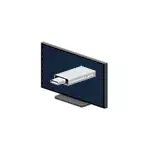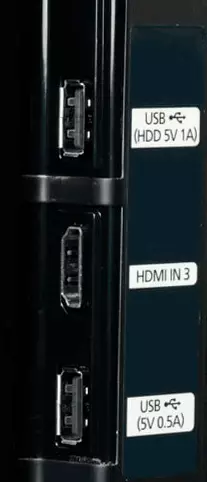
In this instruction, in detail about why TV does not see a USB flash drive and how it can be corrected, as well as some additional information, for example, how to be if the drive is determined, but the films are not shown on it. Attention: If you have a USB connector on your TV, signed as Service, Service ONLY and in the same way, it is not suitable for connecting a flash drive with your data, but is intended for service purposes. It can also be interesting: how to connect the TV to a computer or laptop.
- Why the tv sees the flash drive and how to fix it
- Unsupported file system or partitions on a flash drive
- Flash drive more defined
- Use of hubs, extension centers, large amounts of USB devices
- Other causes of the problem
- Additional information about connecting USB drives to TV
Why the tv sees the flash drive and how to fix it
Among the main reasons why TV may not see the connected USB USB flash drive:- Unsupported file system
- Several sections on the flash drive
- The volume of the drive is more supported, especially on old TVs
- Using extension cables and USB hubs to connect flash drive to TV
- Several USB devices are connected to the TV.
- A large number of files and folders with a complex structure on the drive
- The flash drive is defined not as a removable drive, but as a local disk
- Flash drive is faulty
Perhaps already describing the main reasons why a flash drive may not be visible on the TV will be sufficient, but just in case for each item separately.
Unsupported file system or several partitions on the flash drive
Modern TVs usually support reading from all common files - FAT32, EXFAT and NTFS (the latter is usually not supported for recording). However, some old models, and possibly individual brands of modern TV do not work with NTFS.
Additionally, it happens, especially if the flash drive is more than a certain amount (for example, 64 GB or previously used to create a boot drive), which is more than one partition on the flash drive, and you may not see it, due to the fact that the second section is very small and Not displayed on the computer. In such a situation, TV may not read this flash drive.
General Instructions Here - Delete all sections from a flash drive and format it in FAT32 or EXFAT on a computer ( Attention: All current data will be deleted from it), and then connect to the TV and check if it works now. Steps look like this:
- Connect the USB flash drive and run the command prompt on the administrator. In the command line, enter the following commands.
- diskpart.
- List Disk (command will display a list of disks, you need to look at the number of the disk that matches your flash drive. Be very careful not to confuse).
- SELECT DISK N (here instead n Specify the number of the flash drive from the previous command).
- Clean (cleaning flash drive from all data)
- Format FS = FAT32 Quick (Formatting to the FAT32 file system as the most supported. You can also try EXFAT if you are not satisfied with the 4 GB limit on the size of a single file, but some TVs, such as the most new Samsung, do not support this file system. Most New TV supports NTFS at least for reading).
- EXIT.
After that, close any video files to the USB flash drive, better use the most common MP4 formats with H.264 codec) and photo, connect the drive to the TV and check if it is visible now.
The volume of the flash drive is more supported by TV
Some TVs have limitations on the size of the connected USB drives. Moreover, in a strange way, these restrictions differ depending on the type of drive, for example, if you open the LG TV support page, then the following information will be found there:- Supported external USB disks - 1 TB.
- Supported USB size flash drive - 32 GB.
Strange, but other TVs sometimes have the same picture. Moreover, for some brands, such as Samsung, Sony or Philips on the official website, it is possible to find only the upper border in relation to USB HDD and nothing about the flash drives, although on the experience on some of them, large volumes are ceased to be determined. If you are not sure, just in case, read the instructions (ideally - paper, which was complete with TV) specifically to your model of the TV, maybe there there is a necessary information.
Use of hubs, extension centers, connected multiple devices, USB standards
If several USB devices are connected to your TV or to connect a flash drive, you use some kind of extension cable or USB hub, try to disable it all and then connect only the USB flash drive and nothing else to the USB connector on the TV.

If the flash drive is still not visible in the selected connector, try another connector on the TV (provided that there are several of them). And in the event that a USB 3.0 connectors (usually) and USB 2.0 connectors are present on the TV, check the drive and in those and in others. Also, if possible, make sure that the TV detects other flash drives (to understand which side is the problem).
Other reasons for problems with the connection of the flash drive to TV
Among other reasons why TV does not see a flash drive (or its contents) and the problem solving methods can be allocated as follows:- A complex folder structure, a large number of files (in the LG stated limit - 1000, Samsung - 4000), for some TVs - Russian letters in file names and folders (most often concerns televisions not certified for use in the Russian Federation).
- Some TVs (for example, some not new samsung) support only flash drives that are defined as a "removable drive" (USB Mass Storage Class). You can check the flash drive on the computer: if it is visible in the conductor as a removable drive - everything is in order. If as a hard disk is the cause of the problem.
- The disadvantage of USB power from the TV, but this usually occurs when the external hard drives are connected, and not flash drives.
- Fault USB connector on TV (then it will not see other flash drives).
- The malfunction of the drive itself, in this case it will not work with it and on other devices, for example, on the computer.
And one more point: Sometimes, in the case of such problems, a reboot helps (yes, that's what) of the TV - turn off the USB flash drive, turn off the TV, turn it off from the outlet for several minutes, turn on again, plug the USB drive.
Additional information about connecting usb flash drives to tv
Among other things, it should be borne in mind that the TV can see a flash drive, but not to show its contents if it is not supported. Most often it concerns video files with unsupported codecs (regardless of their file expansion). If you are not sure if this is the case, you can copy several photos of JPG to the root of the flash drive - almost any TV can open them, and then check its work on TV.
Also consider that there are MP3 and video files, the content of which is protected from copying: some TVs will not be able to lose them or not even appear in the list available.
